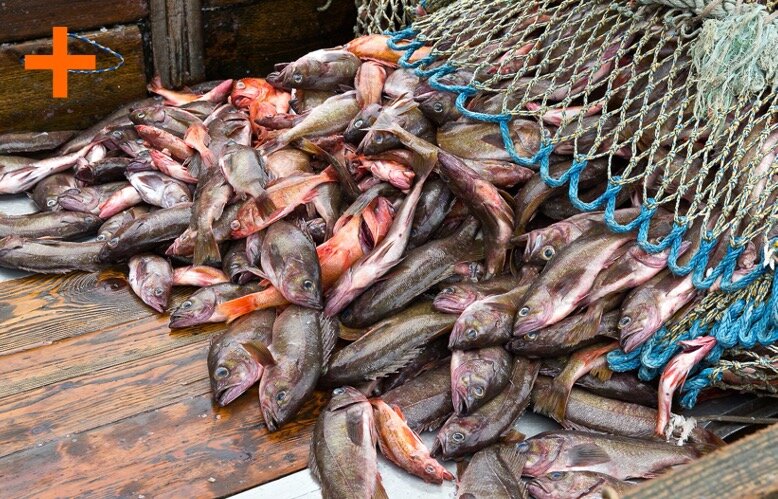WEST COAST GROUNDFISH 101
What are Groundfish?
No, we’re not talking about fish that’s been ground up. “Groundfish” is an umbrella term that refers to many species of fish that dwell near the ocean floor. While there are numerous different groundfish fisheries around the world, Positively Groundfish exclusively works with the West Coast Groundfish fishery, which encompasses 90+ different species of fish that are native to the Pacific and abundant off the coast of California, Oregon and Washington state. This multi-species fishery includes over 50 species of Rockfish, 8 species of Sole, as well as Sablefish (Black Cod), Lingcod, Pacific Cod, Thornyheads, Flounders, Skates or Pacific Sanddabs.
WEST COAST GROUNDFISH SPECIES
WHAT MAKES OUR FISH SO SUSTAINABLE
Sustainability is an oft-used and oft-misunderstood term that means different things in different contexts. For us it means “perpetual abundance”. It means having more fish in the sea and more for our growing world population to eat, too. So here is what makes our West Coast groundfish fishery so sustainable.
Abundant FISH Populations
West Coast groundfish is one of the most positive sustainability success stories around - NOAA hails it the “comeback of the century”. Following a serious population decline of several of its commercially fished species’ during the 90s and being declared a federal disaster in 2000, this fishery has bounced back to remarkably abundant and ever-growing levels thanks to a total commitment to sustainability by all of its stakeholders.
A SOLID FISHERY MANAgement process
The West Coast groundfish fishery is subject to a rigorous management process through the federally appointed Pacific Fishery Management Council that will ensure the fishery’s continued abundance in future. This entails scientifically set limits on total catch, an individual fishing quota scheme, and limitations on when, where and how fishing can occur (i.e. avoiding spawning season, avoiding sensitive habitats, or gear that minimizes by-catch).
100% monitored + Independently certified
Our fishermen are 100% accountable for their catch. Every single commercial boat that catches West Coast groundfish has an independent observer or an electronic monitoring system on board to ensure compliance and complete record keeping. And since 2014, all major West Coast groundfish species have earned certification by the Marine Stewardship Council (MSC), and are rated “Best Choice” by Seafood Watch.
keeping it local
The average seafood product consumed in the US clocks up over 5,000 food miles. In contrast, our groundfish species are caught and filleted locally on the US West Coast. Keeping it local drastically minimizes food miles and our carbon footprint, but also maximizes our product freshness and quality. And of course, eating local supports our local communities and rewards our hard-working fishermen that have been committed to sustainable practices for decades.
WHAT MAKES OUR FISH SO HEALTHY
“Healthy” is an admittedly vague term used to sell all kinds of products, services and ideas. For us “healthy” means nutrient-rich, natural and unadulterated foods that we can trust and that enhance our overall well-being. So here is why West Coast Groundfish is so healthy.
WILD & 100% NATURE-MADE
It doesn’t get more ‘natural’ and ‘real’ than wild. All West Coast groundfish species are wild-caught species native to the West Coast of the US. And because they are wild, it requires no land, no fresh water, no feed, nor any chemicals, antibiotics or hormones to ‘produce’ this protein. No adulterating. Just nature at its best. The way it’s been for millennia.
CLEANEST lEANEST Protein-est
Most West Coast groundfish species are exceptionally high in protein and very low in fat and calories. For example, for Pacific Dover Sole 97% of its calories are from protein, while for rockfish it’s 92-95%, and Lingcod comes in at 91% protein - that is twice as high as the protein % of a lean skirt steak. Mind blown! So if you want to optimize your protein intake, Rockfish, Sole or Lingcod are a truly smart choice.
Full of nutritional goodness
West Coast Groundfish are rich in Omega-3, which support heart health, immune health, brain function and joint mobility. In fact, Sablefish has among the highest Omega-3 content of any seafood. A Lingcod has twice as much Omega-3 as an Atlantic Cod, while a Canary Rockfish has 6 times more Omega-3 than Tilapia or Yellowfin Tuna. West Coast groundfish are also great good sources of selenium, which fights inflammation and supports thyroid health, as well as potassium that is needed for the proper functioning of our muscles.
SEAFOOD YOU CAN TRUST
West Coast groundfish are caught by small boats (i.e. 1-3 crew) and filleted locally on the US West Coast in modern facilities, following strict US food safety practices and regulations. This safeguards the product’s freshness, safety and quality, and therefore your eating pleasure.
GROUNDFISH IS DELICIOUS
We could rave about how lip-smacking tasty West Coast groundfish species are until we’re blue in the face, but we think our products speak best for themselves. The Pacific Ocean is providing us with incredible ingredients to cook with. Just go ahead and taste for yourself.
Mild Flakey White Fish
Their clean, sweet taste is easy on the palette, and beautifully carries sauces, be they subtle or intense.
A Versatile protein
West Coast groundfish species lend themselves to countless cuisines and preparation methods.
FAST & Easy TO COOK
Most preparations of our groundfish take but a few minutes. These really are nature’s original fast food.
LOCAL FRESHNESS
Eating local means eating fresh, and that translates directly into great quality and superb taste.


































